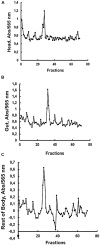Biochemical and Functional Characterization of Glycoside Hydrolase Family 16 Genes in Aedes aegypti Larvae: Identification of the Major Digestive β-1,3-Glucanase
- PMID: 30873040
- PMCID: PMC6403176
- DOI: 10.3389/fphys.2019.00122
Biochemical and Functional Characterization of Glycoside Hydrolase Family 16 Genes in Aedes aegypti Larvae: Identification of the Major Digestive β-1,3-Glucanase
Abstract
Insect β-1,3-glucanases belong to Glycoside Hydrolase Family 16 (GHF16) and are involved in digestion of detritus and plant hemicellulose. In this work, we investigated the role of GHF16 genes in Aedes aegypti larvae, due to their detritivore diet. Aedes aegypti genome has six genes belonging to GHF16 (Aae GH16.1 - Aae GH16.6), containing two to six exons. Sequence analysis suggests that five of these GHF16 sequences (Aae GH16.1, 2, 3, 5, and 6) contain the conserved catalytic residues of this family and correspond to glucanases. All genomes of Nematocera analyzed showed putative gene duplications corresponding to these sequences. Aae GH16.4 has no conserved catalytic residues and is probably a β-1,3-glucan binding protein involved in the activation of innate immune responses. Additionally, Ae. aegypti larvae contain significant β-1,3-glucanase activities in the head, gut and rest of body. These activities have optimum pH about 5-6 and molecular masses between 41 and 150 kDa. All GHF16 genes above showed different levels of expression in the larval head, gut or rest of the body. Knock-down of AeGH16.5 resulted in survival and pupation rates lower than controls (dsGFP and water treated). However, under stress conditions, severe mortalities were observed in AeGH16.1 and AeGH16.6 knocked-down larvae. Enzymatic assays of β-1,3-glucanase in AeGH16.5 silenced larvae exhibited lower activity in the gut and no change in the rest of the body. Chromatographic activity profiles from gut samples after GH16.5 silencing showed suppression of enzymatic activity, suggesting that this gene codes for the digestive larval β-1,3-glucanase of Ae. aegypti. This gene and enzyme are attractive targets for new control strategies, based on the impairment of normal gut physiology.
Keywords: Aedes aegypti; GHF16; Glycoside Hydrolase Family 16; digestion; immunity; knock-down; β-1,3-glucanase.
Figures









Similar articles
-
Digestion of Yeasts and Beta-1,3-Glucanases in Mosquito Larvae: Physiological and Biochemical Considerations.PLoS One. 2016 Mar 23;11(3):e0151403. doi: 10.1371/journal.pone.0151403. eCollection 2016. PLoS One. 2016. PMID: 27007411 Free PMC article.
-
Review: The structure and function of cellulase (endo-β-1,4-glucanase) and hemicellulase (β-1,3-glucanase and endo-β-1,4-mannase) enzymes in invertebrates that consume materials ranging from microbes, algae to leaf litter.Comp Biochem Physiol B Biochem Mol Biol. 2020 Feb;240:110354. doi: 10.1016/j.cbpb.2019.110354. Epub 2019 Oct 21. Comp Biochem Physiol B Biochem Mol Biol. 2020. PMID: 31647988 Review.
-
A glycosyl hydrolase family 16 gene is responsible for the endogenous production of β-1,3-glucanases within decapod crustaceans.Gene. 2015 Sep 15;569(2):203-17. doi: 10.1016/j.gene.2015.05.056. Epub 2015 May 27. Gene. 2015. PMID: 26024589
-
A Novel Digestive GH16 β-1,3(4)-Glucanase from the Fungus-Growing Termite Macrotermes barneyi.Appl Biochem Biotechnol. 2020 Dec;192(4):1284-1297. doi: 10.1007/s12010-020-03368-w. Epub 2020 Jul 28. Appl Biochem Biotechnol. 2020. PMID: 32725373
-
Molecular characterization of genes encoding trypsin-like enzymes from Aedes aegypti larvae and identification of digestive enzymes.Gene. 2011 Dec 10;489(2):70-5. doi: 10.1016/j.gene.2011.08.018. Epub 2011 Sep 2. Gene. 2011. PMID: 21914468
Cited by
-
Rhodnius prolixus Hemolymph Immuno-Physiology: Deciphering the Systemic Immune Response Triggered by Trypanosoma cruzi Establishment in the Vector Using Quantitative Proteomics.Cells. 2022 Apr 25;11(9):1449. doi: 10.3390/cells11091449. Cells. 2022. PMID: 35563760 Free PMC article.
-
Novel, cold-adapted D-laminaribiose- and D-glucose-releasing GH16 endo-β-1,3-glucanase from Hymenobacter siberiensis PAMC 29290, a psychrotolerant bacterium from Arctic marine sediment.Front Microbiol. 2024 Oct 2;15:1470106. doi: 10.3389/fmicb.2024.1470106. eCollection 2024. Front Microbiol. 2024. PMID: 39417081 Free PMC article.
-
Nano-pesticides: the lunch-box principle-deadly goodies (semio-chemical functionalised nanoparticles that deliver pesticide only to target species).J Nanobiotechnology. 2022 Jan 4;20(1):13. doi: 10.1186/s12951-021-01216-5. J Nanobiotechnology. 2022. PMID: 34983544 Free PMC article.
-
High larvicidal efficacy of yeast-encapsulated orange oil against Aedes aegypti strains from Brazil.Parasit Vectors. 2021 May 22;14(1):272. doi: 10.1186/s13071-021-04733-2. Parasit Vectors. 2021. PMID: 34022935 Free PMC article.
-
Myriapod genomes reveal ancestral horizontal gene transfer and hormonal gene loss in millipedes.Nat Commun. 2022 May 30;13(1):3010. doi: 10.1038/s41467-022-30690-0. Nat Commun. 2022. PMID: 35637228 Free PMC article.
References
-
- Avissar Y. J., Margalit J., Spielman A. (1994). Incorporation of body components of diverse microorganisms by larval mosquitoes. J. Am. Mosq. Control Assoc. 10 45–50. - PubMed
LinkOut - more resources
Full Text Sources

